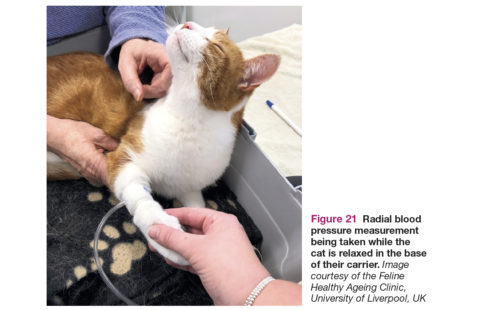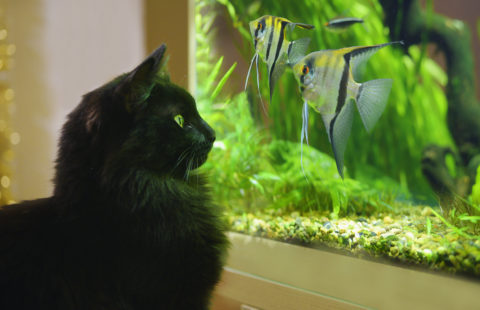This age-old question is, in reality, quite a new one. Historically, domestic cats have generally been in control of where and when they roam, and have experienced little restriction from caregivers. Until fairly recently all cats had to go outside to relieve themselves, as cat litter did not become available until the 1950s. The introduction of litter trays gave cat owners the choice of keeping their cats indoors. However, most owners in Europe still allow their cats the freedom of the great outdoors and then care for, feed and enjoy social interaction with them when they return home. But with the gradual change in the cat’s status from hunter to companion, concern for the cat’s health and welfare, and increased value placed upon the cat, more cats are being kept exclusively indoors. Although only about 10% of pet cats in the UK are believed to live permanently indoors, this figure is increasing, and is already much higher in the USA, where keeping cats indoors is encouraged.
An indoor-only lifestyle for a cat is often chosen by an owner, mainly due to fear for their own cat’s welfare and concern for wildlife populations. Other ethical considerations for keeping cats indoors include cats with certain health conditions, eg, cats with feline immunodeficiency virus (FIV), which pose a risk of infecting other cats with the virus, as well as being more susceptible to picking up infections themselves.
Deaf cats will be at increased risk of accidents eg, road traffic accidents as they cannot hear oncoming traffic, and therefore should be kept inside for their own safety. For some, outdoor access may not simply be possible, for example, if they live in a high rise apartment. Others choose to limit their cats to an inside environment at certain times of the day, eg, keeping them indoors overnight as they feel they are at more risk of a road traffic accident due to reduced visibility of the driver; others restrict their cats’ outside access to a cat-proof fenced garden or outdoor enclosure. In some countries, there are even curfews as to when and where cats can be outdoors. There is almost never a simple answer to whether we should keep cats indoors or let them access the outdoors; each situation has its own welfare implications and there is valid reasoning on both sides. The important thing when making the decision on how to house a cat is to consider each cat as an individual alongside its own set of individual circumstances. Below some of the advantages and disadvantages of both types of living circumstances are described with ideas on how risks associated with each type of living arrangement can be minimised.
Indoor-only cats
Indoor cats often encounter fewer physical risks than those exposed to the outside world and for this reason, many live longer and physically safer lives. They are generally safe from territorial disputes between neighbouring cats that can lead to aggressive feline encounters that may result in injury. In many urban areas, feline populations can be extremely dense. It is difficult for some individual cats to cope with this intense, sometimes constant, presence of unfriendly cats that they have to defend their territory against. However, such disputes are also very possible in a multi-cat indoor environment if the cats do not consider themselves part of the same social group.
Indoor-only cats are also protected from contracting infectious diseases from other cats such as FIV, feline leukaemia and feline infectious peritonitis. There is a reduced risk of certain accidents happening, such as falling from trees, road traffic accidents and drowning, as well as protection from potential predators such as dogs and coyotes (depending on which country the cat resides in) and from people intentionally harming them, and in some cases stealing them. Removal from a cat’s territory and all that is familiar to the cat can be very distressing for a cat.
Many owners are concerned for wildlife populations and therefore upon their own ethical considerations may choose to keep their cat(s) inside, or they may feel pressure from others eg, neighbours to keep their cats indoors, to prevent them from hunting and causing wildlife injuries and fatalities.
Certain breeds and cats of no particular breed but of certain physical appearance may experience specific challenges associated with having access to the outside world. For example, the hairless Sphynx cat may suffer if exposed to cold temperatures or direct sunlight due to their lack of hair. White coloured cats (regardless of breed) are more at risk of skin cancer, particularly on their ears where the fur is most sparse. Long-haired breeds such as Persians, Maine Coons and Norwegian Forest Cats and some domestic long hair cats have such long and dense coats that can become even more difficult to maintain when they have encountered dirt and leaves and are exposed to the elements, and thus may be more susceptible to matting.
There are therefore significant benefits, often to the physical health of the cat, to living exclusively indoors; however, it isn’t as risk-free as it might seem. Accidents still happen within the home such as falls from windows or balconies, poisonings from plants, cleaning products or medications, washing machine/tumble dryer incidents, scalds, burns and ingesting foreign objects are all physical risks exposed to cats who spend time indoors. Furthermore, cats restricted from exploring outside may actually experience more risk if they do to find their way out. Indoor cats are not likely to be as ‘streetwise’ as those outside regularly and may find it difficult to cope with traffic or other animals; they may become lost, startle easily and flee across a road or jump into cars or venture into different homes.
Indoor-only cats may be subject to seeing neighbouring cats enter their gardens or pass their windows without being able to actively chase them away. Furthermore, if such neighbouring cats urine spray in the garden or even against the walls of the indoor-only cat’s home, the indoor cat may be able to smell these but cannot access the areas to over-mark them. These neighbouring cats and their chemical deposits may be perceived as a threat to the indoor cat that the indoor cat cannot deal with and subsequently may induce a significant level of distress for the indoor cat.
Perhaps some of the biggest risks to the welfare of an indoor-only cat are not physical welfare risks but instead, risks to the emotional wellbeing of the cat. The indoor environment, in comparison to the outdoor environment, is generally considered to be more predictable and monotonous. There is also reduced opportunity in an indoor environment for many natural behaviours, such as hunting
and exploration. As a result, a cat may be more at risk of experiencing boredom and frustration, particularly if the indoor environment generally takes into consideration the owner’s needs but not the cat’s environmental needs. The risks to indoor-only cats, such as sharing space with incompatible cats and boredom or frustration, may not be so visible or recognised by owners. However, some cats experiencing these negative emotions begin to display behaviours that owners may find it difficult to cope with, such as scratching furniture, spraying, increased vocalisations, or aggression between cats in multi-cat households. For example, both Heidenbeger (1997) and Amat and colleagues (2009) found in their research that owners who let their cats out only rarely or irregularly or not at all were more likely to report their cats had behaviour problems than owners whose cats were allowed out regularly. Whether this is because indoor-only cats suffer more problem behaviour or that owners simply notice it more, or a combination of both, is currently unknown.
Owners who choose to keep indoor cats, therefore, have an increased responsibility to provide a rich and stimulating environment with plenty of appropriate outlets for performing natural behaviours.
Cats with regular or free access outside
Many disadvantages to cats’ physical welfare by allowing them access to the outside world are well known, ie, contracting a harmful disease, fights or hostility with other cats, picking up parasites, falls, becoming lost, stolen or shut in somewhere, ingesting a poisonous or harmful substance outdoors such as antifreeze, and risk of injury from a road traffic accident (RTA).
In common with other causes of mortality, death on the roads is highest in the first year of life. This may be because the young cat has not yet had time to learn about the dangers in its environment. Research by Gruffydd-Jones & Murray (2017) found that of cats aged 12 months or less, the greatest proportion involved in an RTA were between six and 12 months of age. Research by Rochlitz (2003a) found that cats between 7 months and 2 years of age had the highest risk of being involved in an RTA, and that for every one-year increase in age, the odds of an RTA decreased by 16%. Male cats have been found to be 1.9 times more likely to be involved in an RTA than females, and there were more entire males involved in RTAs than neutered males (Rochlitz 2003a). Males, especially toms (sexually intact males), are at greater risk of RTAs because they roam further. Previous research also suggests that the majority of accidents occur at night, and often (in 48% of cases) occur just outside or very near to the cat’s home (Rochlitz 2003b).
There is debate as to which types of roads are most dangerous to cats, those that are constantly busy or those that have intermittent traffic. Rochlitz (2003b) found that proportionally more RTAs involving cats occurred in areas with higher levels of traffic. Gruffydd-Jones & Murray (2017) found that cats living in rural locations were more likely to be involved in an RTA than those living in towns, cities or suburban locations. This may be because cats living in these areas are less ‘streetwise’ because they are not as frequently exposed to traffic. Traffic travelling on rural roads may also be faster-moving than urban traffic. Also, urban roads may be more likely to have pavements which cats can use. Cats living in a house next to a long, straight section of road were also more likely to be involved in an RTA. Drivers may travel faster on these stretches of road and so be unable to stop in time. Finally, cats that were reported to hunt at the roadside were also more likely to be involved in an RTA.
A less obvious downside to outdoor access is the impact on their social environment and, depending on the cat population outside the home, there can be serious emotional welfare implications for the cats concerned. It is normal for cats to share their home range with other cats in the area, but if possible, they will tend to avoid one another and naturally develop a timeshare arrangement.
However, cats will actively defend the area they consider their territory from cats they do not consider part of their social group.
With the increase in popularity of pet cats, in urban areas, it is common to find an increased number of cats attempting to monopolise a piece of land they all consider their own or a part of their own territory. This increase in social pressure can be difficult for some cats to cope with and can lead to open aggression and injury or more passive aggression such as intimidation through staring and even invading another cat’s core territory by entering its home. The caveat to this is there are always some cats that make friendships with neighbouring cats and enjoy their company, but this is generally in the minority – most will try to actively avoid each other.
In some areas, for example very urban areas, outside access may not be as enriching as expected considering the modern, minimalist gardens or courtyards many cats may have access to; some may live in areas with no gardens. Such areas lack elements cats enjoy such as large trees, shrubs
for exploring and hiding under and suitable latrine areas.
As such, the outside world is not always as exciting as it seems, nor does it compensate for inadequate conditions inside the home. However, it does allow the cat an opportunity to vote with their feet and relocate to another household or join the stray population if they are unhappy with their home environment, although this may not be in the owner’s best (or even the cat’s best) interests.
Of course, there are many clear advantages to allowing cats access to the outside world, one being that it simply provides a larger, more varied environment for the cat to enjoy. The benefits of allowing cats outdoor access include:
- Increased opportunity for physical exercise and exploration. Hunting, climbing and patrolling territory means cats get exercise and outdoor cats tend to be slimmer than their indoor counterparts. In fact, Rowe and her colleagues (2015) found restricted outdoor access to be a risk factor for owner-reported obesity, highlighting the benefit of the opportunities for active behaviours present outside the home.
- Opportunity for predatory behaviour (although often not considered an advantage by owners!).
- Ever-changing elements that stimulate each of a cat’s senses.
- Increased choice over locations of where to perform behaviours such as toileting.
Outside provides an greater outlet for performance of a range of normal behaviours that are not always appreciated by an owner if they occur indoors. One example is urine spraying which is a normal way for cats to communicate with other members of the feline population in the outdoor world. Spraying inside does not provide an ideal opportunity to do this and if a cat sprays inside, is usually a sign that something is upsetting them. Scratching for marking reasons is another example, as such scratching often occurs on the boundaries of the territory, but if the territory is exclusively indoors and adequate scratching posts in appropriate places are not provided, such scratching may occur in areas owners find undesirable such as sofas or door frames. An outdoor environment provides so much more choice over scratching places.
Generally, an outdoor environment gives a cat more control over its actions – less confinement can lead to less frustration. Indoor-only cats often live well into their teenage years and during their lifetime owners are very likely to experience significant changes to the environment. New babies, house moves, new partners, new pets, building work, redecorating are just a few examples of changes that would influence the cat’s territory. Allowing outside access provides an opportunity to gain distance from these stressors (even temporarily) and ultimately can help them to cope.
In multi-cat households, a larger home territory as provided for by allowing outdoor access, allows cats to space themselves more effectively. Many problem behaviours are the result of cats being kept in close proximity to other cats. Outdoor access means cats can get away from each other and establish their own territory or to be able to time share space more easily. This is particularly important for cats who do not consider themselves part of the same social group.
The debate as to whether cats should be kept inside or allowed to roam freely is a difficult one with very good arguments on each side. In all cases, the decision should be made in relation to the individual cat and their own preferences, as well as the type of environment they will be exposed to if allowed to roam. Every effort should always be made to minimise the risks associated with indoor living (for all cats) and outdoor living (for those with outdoor access).






